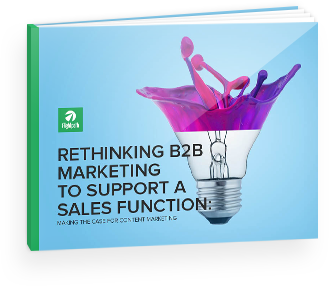Ask any digital marketer what it means to create an experience and you’ll probably get a different answer every time. But as marketers, our job is to figure out how creating an ‘experience’ applies to our customers and prospects, or else our engagement efforts will fall short. The most forward thinking brands create engagement because […]
Ask any digital marketer what it means to create an experience and you’ll probably get a different answer every time. But as marketers, our job is to figure out how creating an ‘experience’ applies to our customers and prospects, or else our engagement efforts will fall short.
The most forward thinking brands create engagement because they have an innate understanding of their audience and what it takes to get their attention. So whether you’re B2B, B2C, or a combination of both, it all comes down to how well you know your buyer.
True that if you’re a big brand with huge dollars to pour into branding campaigns, it becomes part of the overall marketing mix. But with some evidence that advertising is continuing to have diminishing returns, many of the large brands are adopting big time content strategies.
Behaving like a media company
In the content marketing world, we like to use Red Bull as the premier example in that they’ve come out and said publicly that they’re a media company and not a products company. When on their website, you have to dig pretty deep to find information about the energy drink amidst videos and events focusing on extreme sports. In fact, Red Bull has their own channel on Apple TV — now that’s creating an experience.
Yes, the athletes are wearing Red Bull logos. But that’s about the extent that it’s about them.
Going full media company is probably too extreme for most brands, but you do need to at least marry old line marketing services with more media company tactics.
Think about how a magazine works for example. A magazine has a narrative that’s based on what their readers want. They then map content to those wants.
Thinking experiential in our campaigns
If full-blown media company is too much to fathom, we simply need to adjust our thinking at the campaign level. What can we do to engage our prospective customers in such a way that we generate an experience AND communicate our brand messages?
One great example is a campaign that GAF did to engage their channel partners. If you’ve ever worked with channel partners, you know how difficult it is to get them to pay attention to you, let alone the cost of sending reps out to give their spiel that’s destined to fall on deaf ears.
GAF wanted their Home Depot reps to know six basic things about their roofing material when recommending it to customers. So what did they do?
They created a digital game that incorporated the basic messages they needed to hammer home. To add to the incentive, they offered a store-wide pizza party for the winning Home Depot location after three months of play.
The result was an unheard of 10-minute average user engagement! Talk about creating experience.
The editorial mission statement
So how do you go about creating a more engaging campaign for your customers? A clear and defined editorial mission statement, to start.
Check out the following mission statements from Forbes Media and Cooking Light:
- Forbes Media is a global media, branding, and technology company, with a focus on news and information about business, investing, technology, entrepreneurship, leadership, and affluent lifestyles.
- Cooking Light empowers people to cook more for good health. Built with fresh, accessible ingredients and weeknight-friendly techniques, our recipes enable busy home cooks to make healthy and delicious food choices for their families. Our modern approach to cooking and eating healthfully allows everyone to enjoy all the foods they love in a balanced and mindful way.
Notice that these statements are NOT the mission for the company. They are also not the brand missions. The biggest difference is that company mission statements are about what the brand aspires to be (about the company) and an editorial mission statement is about what the niche audience wants (about them).
[Tweet “Editorial mission statements are about what the niche audience wants.”]
Noticing a trend here? It’s not about us anymore. It’s about the audience.
Why is an editorial mission statement important? Prioritization of content. It keeps you on track for what you should be publishing and what you should not.
With established brands, sometimes the brand strategy gets in the way of what you should be developing to engage your audience. You don’t clearly understand the “who” and the “why” for your content and your brand. Not only does this provide a lackluster and inconsistent experience for your audience members, but it can make you feel like you are creating content for everyone that satisfies no one.
The point is to add value to your prospects and create an experience—that’s what gets them to engage with your brand in the modern digital era.
Creating a more effective customer engagement strategy is certainly not easy — it’s something that we spend all day every day thinking about for our clients and customers. But we do know the foundation of a superior brand experience: keep your brand out of it.
[Tweet “The foundation of a superior brand experience: keep your brand out of it.”]

